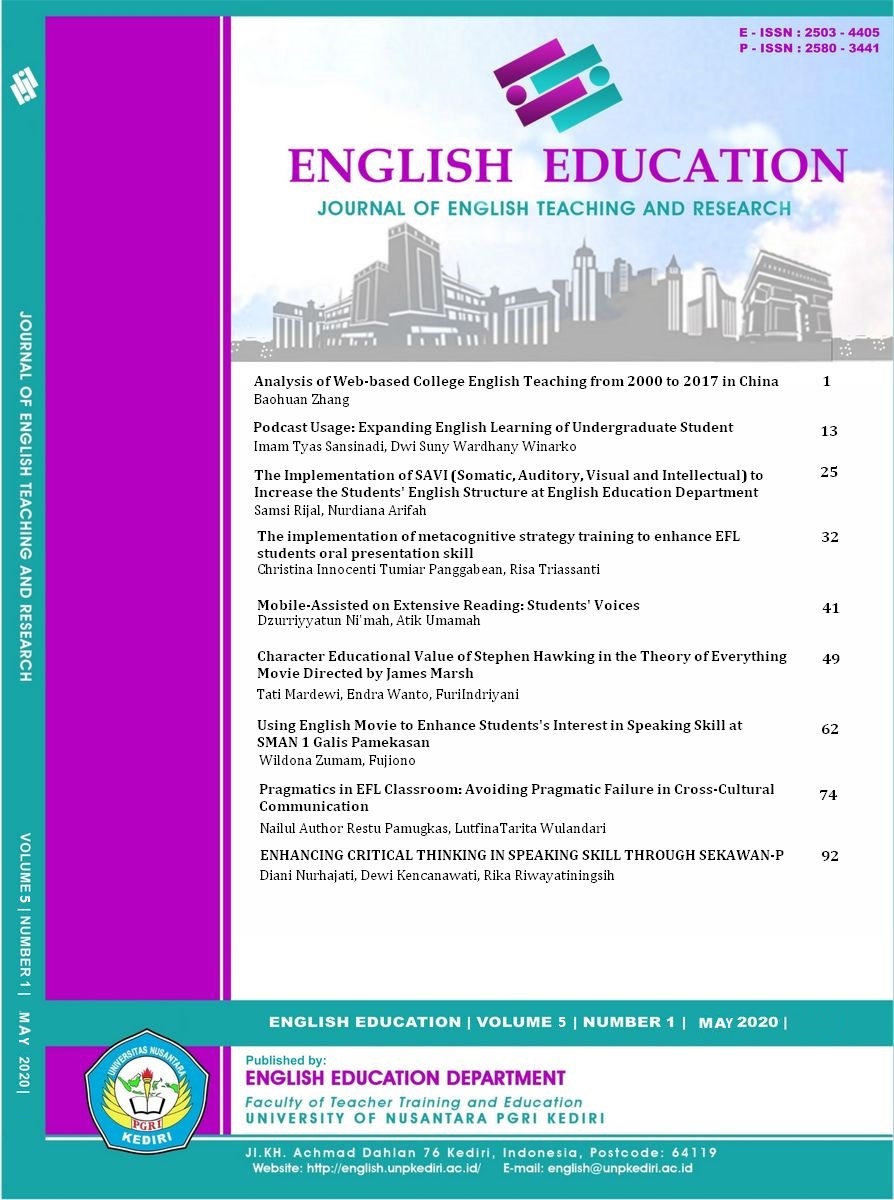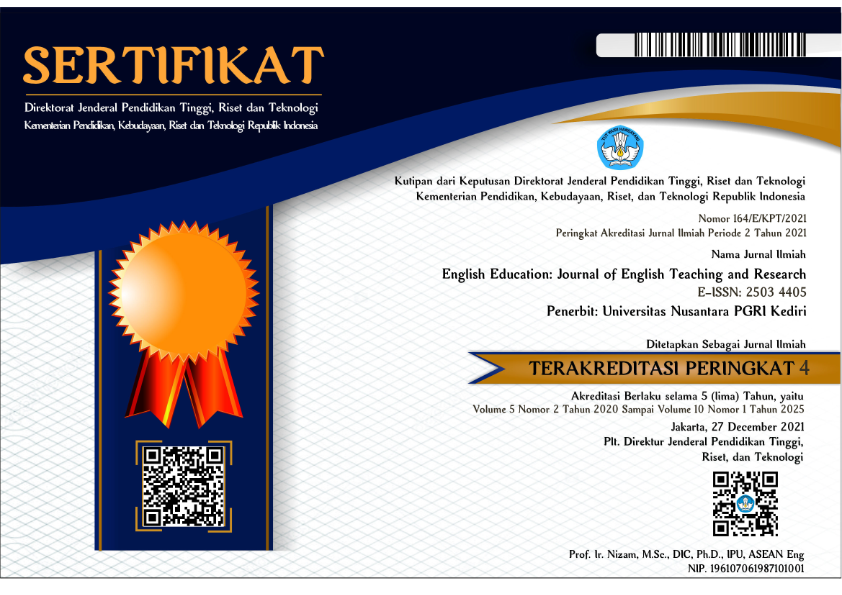ANALYSIS OF WEB-BASED COLLEGE ENGLISH TEACHING FROM 2000 TO 2017 IN CHINA
DOI:
https://doi.org/10.29407/jetar.v5i1.14251Keywords:
college english teaching, network, spatio-temporal differencesAbstract
Based on 812 papers on web-based college English teaching published in Chinese journals from 2000 to 2017, this study adopted modern statistical methods to explore the spatio-temporal development of the research. The results revealed the research on web-based college English teaching started in 2000 and had been increasing from 2006 to 2011; however, scholars’ attention to it was on the decline after 2012. During the period of 2000 -2017, the average annual number of papers published in Chinese journals was up to 45 while that in core journal was only 4. Meanwhile, there were significantly spatial differences. The research on web-based college English teaching in China has mainly focused on eastern region, particularly, Beijing and Guangdong as two main research regions, its average annual number of papers issued in core journals accounted for 9.5% of the total amount of the country respectively. We can see many well-known experts in "double first-class" universities pay little attention to the research on web-based college English teaching and there are weak foundation and low faculty. In recent years, college English teaching has been closely related to internet, also, colleges and universities increasingly put more emphasis on the significant influence of network on college English teaching, and however, the research level of web-based college English teaching needs to be improved further from the perspective of the quality and quantity of the published papers.
Downloads
References
An, Q.(2009). An Empirical Study Based on College English Teaching with the Background of Networks. Computer-Assisted Foreign Language Education, 3,58-62.
Bao, W. (2016). Reconstruction of College English Teachers' Belief against the Background of Connotative Development. Journal of Jilin Engineering Normal University, 32(9), 19-20.
Chen, J. L., &Wang, J. (2016). On the Development of “Normal”in IT-based Foreign Language Education. Computer-Assisted Foreign Language Education, 2,3-9.
Chen, J. L. (2006). On the Integration of Computer and Internet into Foreign Language Teaching Program—From an Ecologic. Technology Enhanced Foreign Language Education, 6,3-10.
Fu, L. F.,&Yang, J. D. (2007). Research on Autonomous Learning Ability Based on Network Multimedia College English Teaching Model. Foreign Languages and Their Teaching, 10,36-38.
Huang, L. (2014). On the 30-year Development of College English Teaching Research in China (1983-2012). Foreign Language World, 6,57-65.
Jia, G. D. (2009). College English teaching model based on classroom and network. China University Teaching, 6,82-85.
Jia, G. D. (2016). Methods,means and resources of English teaching in the Guidelines on College English Teaching. Foreign Language World, 23, 11-18.
Jia, G. D. (2003). Modern Network Technology and the Reform of College English Teaching Model--Design and Experimental Research Based on Campus Network Teaching Model. Foreign Language World, 6, 22-29.
Jia, G. D. (2011). Research on Network-based Eclectic College English Teaching Model. China University Teaching, 6,75-77.
Li, C. G. (2013). Study on the Application of Multimode Learning Environment Based on Internet to the College English Teaching for Music, Sports and Arts Majors. Technology Enhanced Foreign Language Education, 5, 71-75.
Li, L. (2008). The Effect of Network-based Language Teaching on ReadingCompetence-a Study of How to Lower Learners' ForeignLanguage Anxiety. Guizhou University.
Li, M. H. (2007). College English Teaching Based on Computer Network. Technology Enhanced Foreign Language Education, 1,32-35.
Liu, W. Y, &Xiang, B. H. (2000). Network and College English Teaching. Foreign Languages and Their Teaching, 10,62-62.
Qin, L.Y. (2004). Thoughts on College English Teaching Model Under the Environment of Multimedia Network Technology. Modern University Education, 4,107-109.
Sui, X. B. (2013). The Optimization Research on Web-based College English Classroom Teaching--an Empirical Study in Jiamusi University. Shanghai International Studies University.
Sun, Z. N. (2017). Learners' Satisfaction Towards College English Autonomous Learning Platform. Technology Enhanced Foreign Language Education, 3, 15-21.
Wang, B. R. (2010). Application of Project-based Learning to College English Teaching in the Networked Environment. Journal of Northeastern University(Social Science), 12(2), 168-172.
Wang, H. X. (2016). The Practice and Effect of College English Teaching Reform Under the Background of "Internet +". English Square, 08, 115-116
Wang, Q.M. (2002). Reasons for Ineffective College English Teaching and Relevant Countermeasures. Foreign Language World, 4,27-35.
Wang, Y. P. (2006). Research on Evaluation System of College English Teaching under the Environment of Multimedia Network. Foreign Language World, S1, 117:96-107.
Wang, Z., &Xia, J.M. (2010). The Effects of College English Teaching-learning by Combination ofNetwork and Classroom. Computer-Assisted Foreign Language Education, 3,13-20.
Wu, Y. J. (2006). Discussion on College English Teaching Model Based on Computer Network. Modern Education Science, 1,100-103.
Xiao, L. R., &Yu, Z. (2002). On the Opportunities and Challenges Brought by Computer Network Technology to College English Teaching. Foreign Languages Research, 5, 66-69.
Yin, S. Q., Zhang, J. L., Ren, L. (2011). Research Hotspots Analysis of Digital Library Based on Keywords Co-occurrence Analysis and Social Network Analysis. Journal of Academic Libraries, 29(4), 25-30.
Zhang, H. (2003). Exploration of College English Teaching Model under the Environment of Multimedia and Network. Computer-Assisted Foreign Language Education, 2,37-40.
Zhang, H. (2002). Web-based College English Teaching. Modern Educational Technology, 12(4), 49-52.
Zhu, F. D. (2004). The Leading Role of Teachers in Network-assisted College English Teaching. Foreign Language World, 1, 48-53.
Downloads
Published
Issue
Section
License
Authors who publish with this journal agree to the following terms:
- Copyright on any article is retained by the author(s).
- The author grants the journal, the right of first publication with the work simultaneously licensed under a Creative Commons Attribution License that allows others to share the work with an acknowledgment of the work’s authorship and initial publication in this journal.
- Authors are able to enter into separate, additional contractual arrangements for the non-exclusive distribution of the journal’s published version of the work (e.g., post it to an institutional repository or publish it in a book), with an acknowledgment of its initial publication in this journal.
- Authors are permitted and encouraged to post their work online (e.g., in institutional repositories or on their website) prior to and during the submission process, as it can lead to productive exchanges, as well as earlier and greater citation of published work.
- The article and any associated published material is distributed under the Creative Commons Attribution-ShareAlike 4.0 International License








 Article template
Article template



